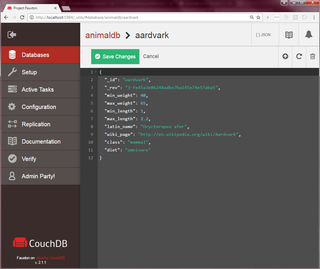
Db2 is a family of data management products, including database servers, developed by IBM. It initially supported the relational model, but was extended to support object–relational features and non-relational structures like JSON and XML. The brand name was originally styled as DB/2, then DB2 until 2017 and finally changed to its present form.
Apache Hadoop is a collection of open-source software utilities that facilitates using a network of many computers to solve problems involving massive amounts of data and computation. It provides a software framework for distributed storage and processing of big data using the MapReduce programming model. Hadoop was originally designed for computer clusters built from commodity hardware, which is still the common use. It has since also found use on clusters of higher-end hardware. All the modules in Hadoop are designed with a fundamental assumption that hardware failures are common occurrences and should be automatically handled by the framework.

Apache CouchDB is an open-source document-oriented NoSQL database, implemented in Erlang.
HBase is an open-source non-relational distributed database modeled after Google's Bigtable and written in Java. It is developed as part of Apache Software Foundation's Apache Hadoop project and runs on top of HDFS or Alluxio, providing Bigtable-like capabilities for Hadoop. That is, it provides a fault-tolerant way of storing large quantities of sparse data.
A database shard, or simply a shard, is a horizontal partition of data in a database or search engine. Each shard is held on a separate database server instance, to spread load.
DataNucleus is an open source project which provides software products around data management in Java. The DataNucleus project started in 2008.
Structured storage is computer storage for structured data, often in the form of a distributed database. Computer software formally known as structured storage systems include Apache Cassandra, Google's Bigtable and Apache HBase.

Apache Hive is a data warehouse software project built on top of Apache Hadoop for providing data query and analysis. Hive gives an SQL-like interface to query data stored in various databases and file systems that integrate with Hadoop. Traditional SQL queries must be implemented in the MapReduce Java API to execute SQL applications and queries over distributed data. Hive provides the necessary SQL abstraction to integrate SQL-like queries (HiveQL) into the underlying Java without the need to implement queries in the low-level Java API. Since most data warehousing applications work with SQL-based querying languages, Hive aids portability of SQL-based applications to Hadoop. While initially developed by Facebook, Apache Hive is used and developed by other companies such as Netflix and the Financial Industry Regulatory Authority (FINRA). Amazon maintains a software fork of Apache Hive included in Amazon Elastic MapReduce on Amazon Web Services.
A cloud database is a database that typically runs on a cloud computing platform and access to the database is provided as-a-service. There are two common deployment models: users can run databases on the cloud independently, using a virtual machine image, or they can purchase access to a database service, maintained by a cloud database provider. Of the databases available on the cloud, some are SQL-based and some use a NoSQL data model.

Oracle NoSQL Database is a NoSQL-type distributed key-value database from Oracle Corporation. It provides transactional semantics for data manipulation, horizontal scalability, and simple administration and monitoring.
Apache Impala is an open source massively parallel processing (MPP) SQL query engine for data stored in a computer cluster running Apache Hadoop. Impala has been described as the open-source equivalent of Google F1, which inspired its development in 2012.

Apache Spark is an open-source unified analytics engine for large-scale data processing. Spark provides an interface for programming clusters with implicit data parallelism and fault tolerance. Originally developed at the University of California, Berkeley's AMPLab, the Spark codebase was later donated to the Apache Software Foundation, which has maintained it since.

Apache Trafodion is an open-source Top-Level Project at the Apache Software Foundation. It was originally developed by the information technology division of Hewlett-Packard Company and HP Labs to provide the SQL query language on Apache HBase targeting big data transactional or operational workloads. The project was named after the Welsh word for transactions. As of April 2021, it is no longer actively developed.
Apache Phoenix is an open source, massively parallel, relational database engine supporting OLTP for Hadoop using Apache HBase as its backing store. Phoenix provides a JDBC driver that hides the intricacies of the NoSQL store enabling users to create, delete, and alter SQL tables, views, indexes, and sequences; insert and delete rows singly and in bulk; and query data through SQL. Phoenix compiles queries and other statements into native NoSQL store APIs rather than using MapReduce enabling the building of low latency applications on top of NoSQL stores.
Presto is a distributed query engine for big data using the SQL query language. Its architecture allows users to query data sources such as Hadoop, Cassandra, Kafka, AWS S3, Alluxio, MySQL, MongoDB and Teradata, and allows use of multiple data sources within a query. Presto is community-driven open-source software released under the Apache License.

Apache Kylin is an open source distributed analytics engine designed to provide a SQL interface and multi-dimensional analysis (OLAP) on Hadoop and Alluxio supporting extremely large datasets.
Apache Parquet is a free and open-source column-oriented data storage format in the Apache Hadoop ecosystem. It is similar to RCFile and ORC, the other columnar-storage file formats in Hadoop, and is compatible with most of the data processing frameworks around Hadoop. It provides efficient data compression and encoding schemes with enhanced performance to handle complex data in bulk.

DBeaver is a SQL client software application and a database administration tool. For relational databases it uses the JDBC application programming interface (API) to interact with databases via a JDBC driver. For other databases (NoSQL) it uses proprietary database drivers. It provides an editor that supports code completion and syntax highlighting. It provides a plug-in architecture that allows users to modify much of the application's behavior to provide database-specific functionality or features that are database-independent. This is a desktop application written in Java and based on Eclipse platform.

Trino is an open-source distributed SQL query engine designed to query large data sets distributed over one or more heterogeneous data sources. Trino can query datalakes that contain open column-oriented data file formats like ORC or Parquet residing on different storage systems like HDFS, AWS S3, Google Cloud Storage, or Azure Blob Storage using the Hive and Iceberg table formats. Trino also has the ability to run federated queries that query tables in different data sources such as MySQL, PostgreSQL, Cassandra, Kafka, MongoDB and Elasticsearch. Trino is released under the Apache License.









